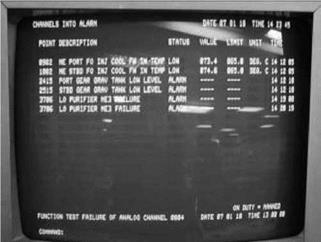• A method of acknowledging all alarms (i. e., to silence audible alarms and to set visual alarms to steady state), including the indication of the source of the alarm, should be provided at the navigating and manoeuvring workstation, to avoid distraction by alarms that require attention but have no direct influence on the safe navigation of the ship and that do not require immediate action to restore or maintain the safe navigation of the ship. In order to judge this, alarm information must be available at the same place.
• The alarm indicators and controls of the fire alarm and emergency alarm should be located at the safety workstation.
• Alarms should be provided to indicate failure or reduction in the power supply that would affect the safe operation of the equipment.
• Alarms should be provided to indicate sensor input failure or absence.
• Alarm systems should clearly distinguish between alarm, acknowledged alarm, and no alarm (normal conditions).
|
FIGURE 9.22 Alarm list shown on a computer screen. (Personal photograph of M. Lundh.) |
• Alarms should be maintained until they are acknowledged.
• Alarms and acknowledged alarms should only be capable of being cancelled if the alarm condition is rectified. This cancellation should only be possible at the individual equipment.
• The number of alarms should be minimised.
• Alarms should be indicated in order of sequence and provided with aids for decision making. An explanation or justification of an alarm should be available (on request).
• The presentation of alarms should be clear, distinctive, unambiguous, and consistent.
• All required alarms should be presented through both visual and auditory means.




